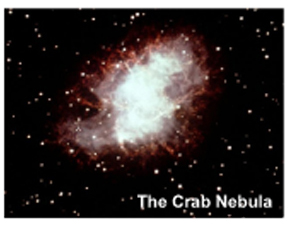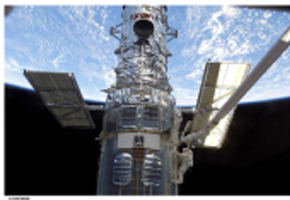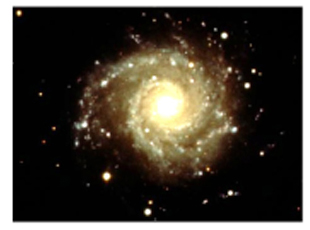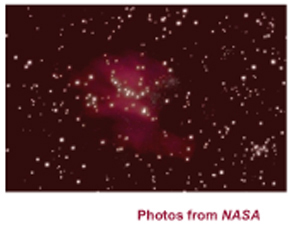HUBBLE'S YOUNG UNIVERSE
LARGE sums of money are currently being spent on space research, as scientists seek to discover the secrets of the universe. Bigger and better telescopes, including the Hubble Space Telescope, have enabled them to study the heavens as never before. Most space scientists are hoping that they will find evidence to support the popular 'big bang' model of the universe. Much to their consternation, more and more evidence is emerging that suggests we live in a young, created universe. In this factsheet we consider three items of particular interest.
SUPERNOVA REMNANTS
Supernovae are exploding stars part of the universal running-down process predicted by the Second Law of Thermodynamics. Initially, supernovae are extremely bright, equal to the power of 100 billion stars, but they slowly fade, and eventually would merge completely into the background of other stars. One famous supernova we now see it as the Crab Nebula was observed by the Chinese in 1054 A.D.

In our own Milky Way galaxy, supernovae occur once every 25 years on average - Canadian astronomer Keith Davies decided to investigate the number of supernova remnants (SNRs) in our galaxy to find out what they told us about the age of the universe. He extracted the relevant data from scientific journals and official records, then calculated how many SNRs should be observable according to the evolutionary, very old universe model - Davies reported his conclusions to the Third International Conference on Creationism at Pittsburgh in 1994.1 He found that with the old universe model, the expected number of observable SNRs in our galaxy is about 7,290. However, if the universe were only 7,000 years old, the expected number is 270. Davies found that the actual number detected was a mere 205! He also discovered that some scientists had been aware of this discrepancy for years, and had expressed concern about the 'missing' SNRs. e.g. Dr. D. Cox: 'The observations have caused considerable surprise and loss of confidence.'2 The National Research Council Astronomy Survey Committee: 'Major questions about these objects that should be addressed in the coming decade are: Where have all the remnants gone?'3 Clark and Caswell: 'Why have the large number of, expected remnants not been detected?'4 Keith Davies commented, 'The number of SNRs observable in the galaxy is consistent with the number expected to be formed in a universe that is 7,000 years old.'5
DEEP SPACE GALAXIES
Evolutionary astronomers believe that as they peer deeper into the universe there are actually seeing further and further into the universe's past. The Hubble telescope has revealed thousands of 'mature' galaxies near the edge of the known universe.

The Hubble Space Telescope.
These astronomers have been disappointed, because the big bang theory would predict only proto-galaxies so 'early' in the history of the universe. Many astronomers expected the number of galaxies to decrease with distance. But because they don't, this 'leaves an uncomfortably short time for galaxies to form after the origin of the universe itself.'6 This evidence strongly suggests that galaxies have not evolved, but were created much as we see them today.

RED DWARFS
What scientists also expected to see on their deep space photographs from the Hubble telescope were thousands of red dwarfs (faint, old stars). Yet, when Dr. Francesco Paresce of the Space Telescope Science Institute and the European Space Agency showed these photographs to the press in November 1994, he said, 'We expected the image to be covered wall-to-wall by faint red stars. There were just a handful there. This was a disaster for the whole way that astronomers are developing the idea of an old universe.'7 (emphasis added). Another astronomer, Todd Lowe, said, 'Listen, we knew this was a shocking result. That's why we spent a year trying to debunk it ourselves before we went public.'8 In the book Hubble Vision, there is a photograph of an actual section of sky showing red dwarf stars alongside a simulated photograph showing the expected number. Keith Davies commented: 'The data fits a young universe, and I mean a Biblical young universe of 10,000 years or less.9

CONCLUSION
Space research has again provided evidence which supports the creation model of a young universe. The expected number of supernova remnants have not been observed, there are mature galaxies near the edge of the universe, and there is a dearth of old, red dwarf stars. We can therefore confidently accept what the Bible tells us: 'By the word of the Lord were the heavens made, their starry host by the breath of his mouth.' (Psalm 33:6).
REFERENCES:
- Distribution of Supernova Remnants in the Galaxy, Proceedings of the 3rd International Conference on Creationism, Creation Science Fellowship, Inc. Pittsburgh, 1994, pp. 175-182.
- Astrophysical Journal 304, 1986, pp. 771-779.
- Challenges to Astronomy and Astrophysics, National Academy Press, 1983, p. 166.
- Monthly Notices of the Royal Astronomical Society, 174:267, 1976.
- As reference 1.
- D. Goldsmith, 'Digging Deeply in Galaxies' Pasts', Science 271:450, 1996.
- Quoted by Keith Davies in 'This Week in Bible Prophecy' 191, TV programme, 1995, Lalonde & Lalonde Inc. Canada.
- Hubble Vision (2nd Edition), Cambridge University Press, 1998, p. 102.
- Interview in 'This Week in Bible Prophecy' 191.
Factsheets published regularly by Creation Resources Trust, P.O. Box 3237, Yeovil, BA22 7WD
(Registered charity No 1016666) www.c-r-t.co.uk © 2003

